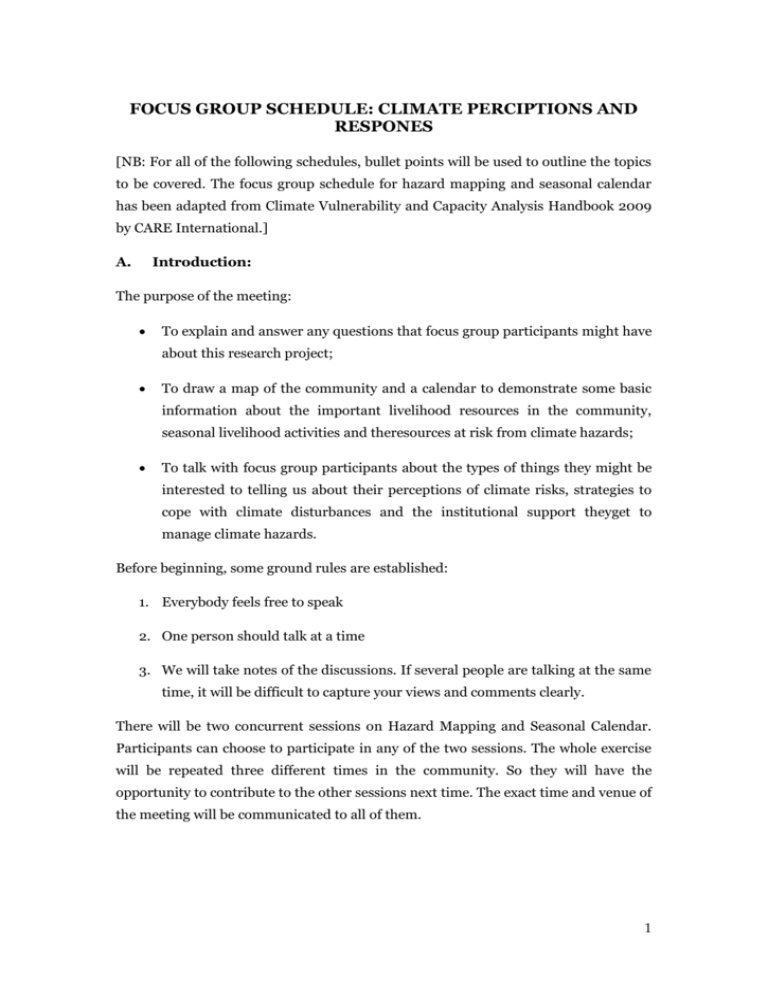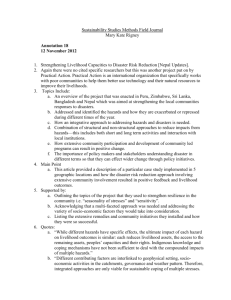focus group schedule: climate perciptions and respones
advertisement

FOCUS GROUP SCHEDULE: CLIMATE PERCIPTIONS AND RESPONES [NB: For all of the following schedules, bullet points will be used to outline the topics to be covered. The focus group schedule for hazard mapping and seasonal calendar has been adapted from Climate Vulnerability and Capacity Analysis Handbook 2009 by CARE International.] A. Introduction: The purpose of the meeting: To explain and answer any questions that focus group participants might have about this research project; To draw a map of the community and a calendar to demonstrate some basic information about the important livelihood resources in the community, seasonal livelihood activities and theresources at risk from climate hazards; To talk with focus group participants about the types of things they might be interested to telling us about their perceptions of climate risks, strategies to cope with climate disturbances and the institutional support theyget to manage climate hazards. Before beginning, some ground rules are established: 1. Everybody feels free to speak 2. One person should talk at a time 3. We will take notes of the discussions. If several people are talking at the same time, it will be difficult to capture your views and comments clearly. There will be two concurrent sessions on Hazard Mapping and Seasonal Calendar. Participants can choose to participate in any of the two sessions. The whole exercise will be repeated three different times in the community. So they will have the opportunity to contribute to the other sessions next time. The exact time and venue of the meeting will be communicated to all of them. 1 B. Hazard Mapping Exercise 1. Explain to the participant that we would like them to draw a community map by asking them to: i) identify a landmark in the community; ii) draw the boundary of the community; iii) draw the locations of settled areas; critical facilities, such as schools, health clinics and mosques; and resources, such as forested areas and water bodies. 2. Ask the community member to identify the areas at risk from multiple hazards on community map: i) Natural disaster ii) Health crises iii) Socio-political issues 3. Noting hazards that are not specific to location, mentioned by participants. 4. When the map is complete, ask the group members the following questions: What are impacts of the hazards identified? Are hazards different now from they were 10/20/30 years ago? How? Are there places in the community that are safe from the hazards? Are these safe places used to protect from hazards? Who are the members of the community that are most at risk from the hazards? Why? How do people in the community currently cope with the impacts of the specific hazards identified? Are the current coping strategies working? Are there different strategies that you would like to adopt which would reduce the impact of hazards on your livelihoods? What resources do you have that would help to adopt these new strategies? 2 What are the constraints to adopting these new strategies? C. Develop a Seasonal Calendar 1. Explain the participant that we would like them to develop a seasonal calendar on large sheets of paper and ask them to: i) Mark off the months along the horizontal axis; ii) List the events, seasons, conditions etc., along the vertical axis. The list includes: Planting and harvesting Period of food availability Timing of migrations Timing of climate events such as flood, cyclone and drought iii) Plot the timing of the key events in the table based on the agreement among the participants. 2. When the calendar is complete, ask the participants the following questions: What the most important livelihoods strategies employed at different points of the year? What are current strategies to cope during difficult times? Are they working? Are there any differences in the timing of seasons and events as compared to 10/20/30 years ago? Have livelihoods/coping strategies changed based on the changing seasons or events? How are decisions made on the timing of livelihoods strategies? 3








